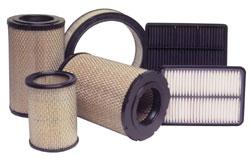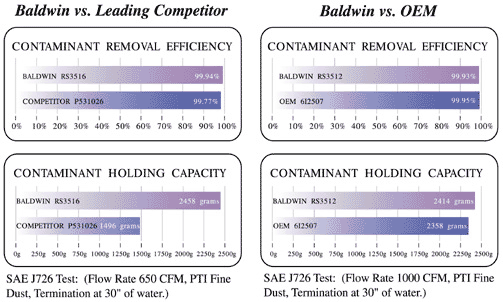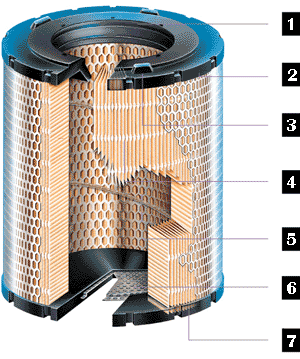| |
|
Ask the Expert - Air Filters
Breathe Easy, Baldwin Is on the Job
 Air is necessary for successful combustion in your engine. In fact, for efficient combustion, a modern diesel engine requires several thousand times as much air as it does fuel. Clean air - air almost 100% pure - is critical to engine survival and vital to its performance. Air is necessary for successful combustion in your engine. In fact, for efficient combustion, a modern diesel engine requires several thousand times as much air as it does fuel. Clean air - air almost 100% pure - is critical to engine survival and vital to its performance.
If you add a turbocharger to your engine, you may need to make changes to the intake ducting. Turbocharged engines require even more free-flowing clean air, 750 cubic feet per minute or more. Naturally aspirated engines demand about 20% less, but still these engines can require up to 15,000 gallons of air for every gallon of fuel. In either case the induction system (ducting, hoses, and reducers) brings outside air to the engine.
- The system should have enough intake capacity to meet engine requirements for air flow, avoiding sharp bends or constrictive ducting.
- It should be installed in a clean location, away from exhaust flow, road grime, and splash.
- It should be vented to remove airborne moisture.
Air may flow into the engine through a series of components:
- An air-inlet hood to eliminate moisture.
- A pre-cleaner that will typically remove 80 to 90% of all airborne contaminants.
- An air-filter housing.
- An ancillary transfer ducting.
Three factors determine the proper size of the air filter to be installed:
- The amount of air flow required for efficient combustion.
- The amount of restriction (resistance to air flow) caused by the filter.
- The amount of dirt the filter will need to hold to allow for a reasonable change interval.
Nearly all filters use pleated cellulose (paper) media. Different formulations of cellulose, resins, and chemical additives meet specialized needs for nonflammability, for example, or for moisture resistance. The pleats in Baldwin air filters are strong, precisely separated, and stabilized.
Baldwin uses two proven methods to separate and stabilize filter pleats.
- PermaPleat® - an embossing process that builds dividers between pleats to prevent bunching and to ensure uniform airf low.
- Beading - a continuous bead of adhesive around the circumference of the filter's metal outer wrap, locking the pleat tips in place and preventing movement.
Most engine manufacturers specify minimum initial efficiency of at least 98.5%. On first reading, this figure seems very high. Remember though, that dirt in any amount can be harmful to your engine.
Air Filter Elements
The Air Filter element establishes a barrier for the separation of airborne contaminants, allowing only clean air to enter the engine. Air filter elements fall into four broad categories:
- Automotive. Both round and panel designs, with molded ends.
- Heavy-Duty Primary. Usually with metal ends, available in both PA (standard) and LL (long-life) models.
- Heavy-Duty Secondary. Used to seal out dirt while the primary filter is being changed.
- Radial Seal. With molded ends and a reinforced closed end - characterized by ease of service.
Maximum Efficiency, Mile After Mile
Most Baldwin heavy-duty air filters have minimum initial efficiencies approaching 99%. Then, as dirt particles begin to accumulate in the filter media, those particles decrease the size of the media's openings, making it more difficult still for even the smallest particles to pass through. As a result, the media's efficiency has actually been increased.
- Heavy-Duty Primary Media routinely achieve initial efficiencies of 98.5% and higher; as the filter loads with dirt, the accumulative efficiency of the media is normally 99.90% or higher.
- Heavy-Duty Secondary Media typically achieve an accumulative efficiency of 85% to 95%. Engine manufacturers also specify the "maximum allowable initial restriction." Baldwin filters meet all these manufacturers' requirements.
Pure Performance: Tested Time & Again
SAE J726, the industry standard for air filtration, determines the rating for all Baldwin Air Filters. Per this SAE spec, the most commonly reported data addresses longevity and efficiency.
Baldwin Air Filters mean pure performance, delivering the clean air that powers your engine now, and extends its useful life thousands and thousands of miles down the road.

Servicing Your Air Filter: Why, When, and How
There are operational signs that an air filter has become completely plugged. The engine begins to lose power, and fuel consumption increases. Black smoke may blow from the exhaust stack. Continued operation with a plugged air filter may very well damage the engine.
It�s impossible to determine, just by looking, when air filters should be changed. An element that looks relatively clean may be almost totally plugged with ultra-fine particles from exhaust smoke or air pollutants.
On the other hand, a filter that looks dirty may still have many hours of useful life. Remember that until maximum acceptable restriction is reached, the accumulation of dirt in the filter actually adds to its efficiency.
A Better Way
Baldwin recommends use of restriction gauges as an integral part of your filter maintenance program. Now standard on many different types of equipment, these gauges measure the amount of vacuum created when air is pulled through the filter, measuring the buildup of dirt from a new filter's installation throughout its useful life. (Check the manufacturer's recommendations for each engine.) If you're not currently using restriction gauges, you really should reconsider. A typical gauge costs less than a new filter element. The payback is immediate:
- Fewer filter servicings and reduced labor costs.
- Reduced risk of damage from over-servicing.
- Less downtime and longer engine life.
Learning From Your Old Filters
Before disposing of old air filters, always inspect them carefully. Their appearance will tell you much about the performance of an entire air-induction system.
- An accumulation of black, oily soot might mean that the air intake is located too close to the exhaust. Consider relocation.
- An accumulation of dirt on the clean side of the filter element might indicate a split in the filter media. Also, determine if the end seal is being bypassed or if a gasket is leaking. Do not attempt to reuse the filter.
- Rust on the filter's metal parts can mean that water is being drawn in with the air. Again, check the location of the intake. Ensure that the water-venting ports in the induction system are clean and free of obstruction.
An Important Caution: Baldwin does not recommend the cleaning of air filter elements. Since all contaminants cannot be removed, service intervals become progressively shorter. Further, the cleaning process might damage the filter, leading to engine damage as well.
Baldwin Radial Seal Air Filters... Designed For Performance

- Heavy-Duty Radial Seal Gasket formed from special nitrile rubber compound. Will not degrade under temperature extremes, changes in restriction or vibration.
- Flexible outer edges allow deflection for easy insertion and removal in housings which have minimum clearance.
- Special Lugs hold filter securely in place to prevent vibration.
- PermaPleat® Construction provides even pleat spacing to prevent bunching and ensure maximum element life.
- Spiral Glue Binding provides added pleat stability to optimize media effectiveness.
- Heavy-Duty End Cap Construction. Center portion specially reinforced to prevent constant flexing and potential failure during changes in intake pressure.
- More Filtration Surface is provided by using a special plastisol binder which does not extend into the path of air flow.
 back to top back to top
|
|
|


 Air is necessary for successful combustion in your engine. In fact, for efficient combustion, a modern diesel engine requires several thousand times as much air as it does fuel. Clean air - air almost 100% pure - is critical to engine survival and vital to its performance.
Air is necessary for successful combustion in your engine. In fact, for efficient combustion, a modern diesel engine requires several thousand times as much air as it does fuel. Clean air - air almost 100% pure - is critical to engine survival and vital to its performance.

